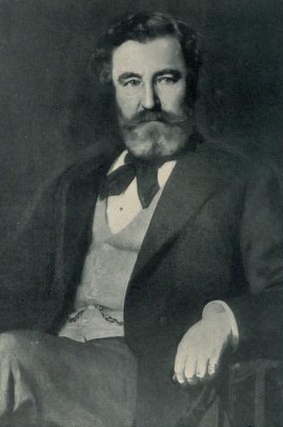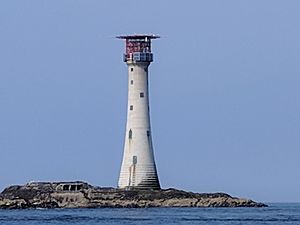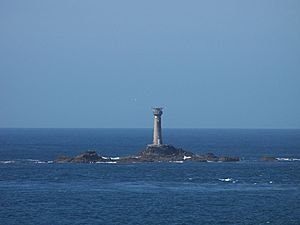James Nicholas Douglass facts for kids
Quick facts for kids
Sir
James Nicholas Douglass
|
|
|---|---|
 |
|
| Born | 16 October 1826 |
| Died | 19 June 1898 (aged 71) |
| Nationality | English |
| Occupation | civil engineer |
Sir James Nicholas Douglass (born October 16, 1826 – died June 19, 1898) was a super talented English engineer. He built and designed many lighthouses. He is most famous for creating the fourth Eddystone Lighthouse. Because of this amazing work, he was even made a knight!
Contents
Meet Sir James Douglass, Lighthouse Builder
James Nicholas Douglass was born in Bow, London, in 1826. He was the oldest son of Nicholas Douglass, who was also an engineer. James learned his skills by working as an apprentice. Then, he joined Trinity House, which is the main group in the United Kingdom that manages lighthouses.
James worked with his brother William and his father. They helped build the Bishop Rock Lighthouse in the Scilly Isles. During this time, James earned the nickname 'Cap'n Jim'. After a short time working for a company that built carriages, he returned in 1854. He helped finish the Bishop Rock Lighthouse and married his fiancée, Mary Tregarthen.
Trinity House then hired James as the main engineer for a new project. He was asked to design the Smalls Lighthouse off the coast of Pembrokeshire, Wales. This was his very first project working on his own!

Douglass based his plans on a strong design by John Smeaton. Smeaton had used special dovetailed granite blocks for the third Eddystone lighthouse. These blocks fit together like puzzle pieces, making the structure very strong. Douglass got his granite from the De Lank Quarries in Cornwall. The stone was then sent to Solva in Wales to be cut and shaped.
The Smalls Lighthouse was finished in 1861. It cost about £50,125 and was built in a record-breaking two years! After this, Douglass immediately helped build the Wolf Rock Lighthouse. In 1862, he became the Chief Engineer for Trinity House.
Douglass's design for the Smalls Lighthouse was a huge success. He went on to design about twenty lighthouses for Trinity House. Some of these were "wave-swept towers," meaning they were built in very rough, wavy seas. These lighthouses, like the Longships Lighthouse off Land's End, are still amazing engineering achievements. Douglass's designs were also used in places like Sri Lanka. His brother William also became a chief engineer for Irish lighthouses.
His Greatest Lighthouse: Eddystone
The biggest achievement in James Douglass's career was building the fourth Eddystone Lighthouse. He was hired to replace the old tower in 1877. The new lighthouse was finished in 1882. What's amazing is that no one was seriously hurt during the building, and it was finished under budget! Soon after, Douglass was made a knight for his great work in engineering. He also worked on making lighthouse lights better, using oil, gas, and even electricity.
In 1887, Douglass was chosen to be a Fellow of the Royal Society. This is a very important group for scientists. He retired in 1892. He passed away in 1898 at his home on the Isle of Wight. His youngest son, Alfred, also became a lighthouse engineer. His oldest son, William Tregarthen Douglass, also became a famous engineer who built lighthouses.
Amazing Lighthouses He Designed
Here are some of the lighthouses that James Douglass designed or helped rebuild:
- Bishop Rock Lighthouse (he helped rebuild it)
- Bow Creek Lighthouse at Trinity Buoy Wharf, London
- The fourth Eddystone Lighthouse
- Hartland Point Lighthouse, Devon
- Dondra Head Lighthouse, Sri Lanka
- Great Castle Head range lights, Milford Haven
- Les Hanois Lighthouse, Guernsey
- Longships Lighthouse, off Land's End, Cornwall
- Old Higher Lighthouse, Isle of Portland, Dorset
- Old Lower Lighthouse, Isle of Portland, Dorset
- St Bees Lighthouse, Cumbria
- Smalls Lighthouse, off Pembrokeshire, Wales
- Souter Lighthouse, Tyne and Wear
- Southwold Lighthouse, Suffolk
- Winterton Lighthouse, Norfolk
Images for kids




